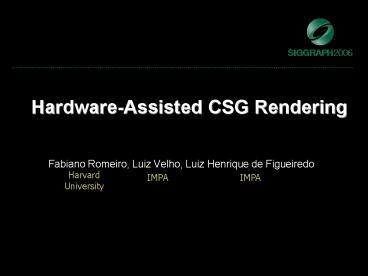HardwareAssisted CSG Rendering PowerPoint PPT Presentation
1 / 12
Title: HardwareAssisted CSG Rendering
1
Hardware-Assisted CSG Rendering
- Fabiano Romeiro, Luiz Velho, Luiz Henrique de
Figueiredo
Harvard University
IMPA
IMPA
2
Motivation
- CSG Hierarchical modeling of complex objects
- Objects generated by boolean combinations of
simple primitives
3
Motivation
- Interactivity is important
- Makes design easier
- However it is dificult
- Scalability
4
Previous Approaches
- Boundary representations
- Depth-layering (Goldfeather)
- Recently algorithms that use GPU resources
(Wiegand, Rappoport, Stewart, Guha, etc) - Blist, Depth-peeling (Hable and Rossignac)
5
Motivation
- Recent approaches try to reach interactivity on
ever more complex models
- Current best performing ones are bandwidth
limited (depth layering, depth peeling, etc)
- GOAL
- Make more use of GPU processing power
- Shift bottleneck from bandwith to GPU instruction
throughput
6
Method Overview
- Perform spatial subdivision of the CSG object on
the CPU until locally it is simple enough to be
ray-traced on the GPU.
- Locally simple enough Surface defined by a
single primitive or boolean operation of two
primitives
7
Method Overview Subdivision Step
- Modified octree (sequenced kd-tree) used as
subdivision structure
Real subdivision example
Illustrative subdivision example in 2D
8
Method Overview Subdivision Step
- Trade-off Increasing threshold increases
performance but introduces noticeable artifacts
9
Method Overview Ray-tracing Step
- Octree is traversed in recursive front-to-back
manner - As leaf cells are reached different action is
taken according to cell classification
10
Method Overview Ray-tracing Step
- As faces are rendered pixel shader runs for every
point of the faces
b) Boolean operation of 2 primitives Shader
a) Single primitive Shader
o
o
o
o
11
Results
- Measurements performed in 2 configurations
- C1 Pentium-M 1.4GHz, Geforce FX Go5200
- C2 Athlon 64 3800, Geforce 6800 GT
- To identify bottlenecks and evaluate performance
we measured - S Subdivision time (CPU)
- TR Traversal and rendering time (GPU)
- Ts Setup time (Bandwidth)
12
Results
CK200
CK500
CK1000
WIDGET
13
Conclusions
- Results comparable performance-wise to current
top performing methods - For models with up to 500 primitives mostly
GPU instruction throughput limited - With newer GPUs, we expect our method to surpass
other methods on such models

